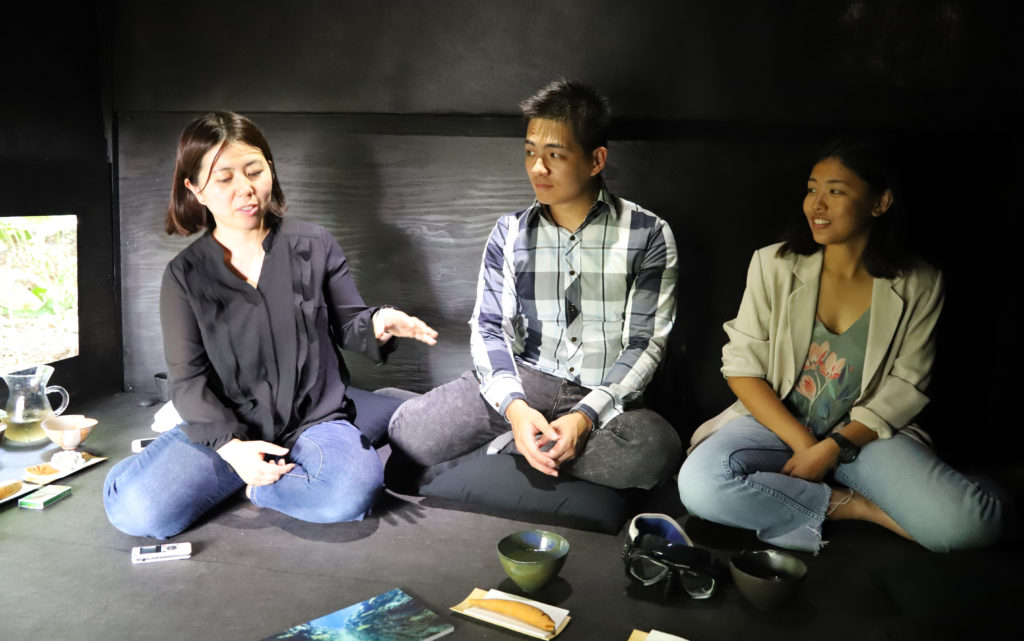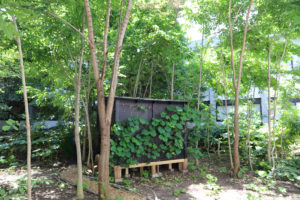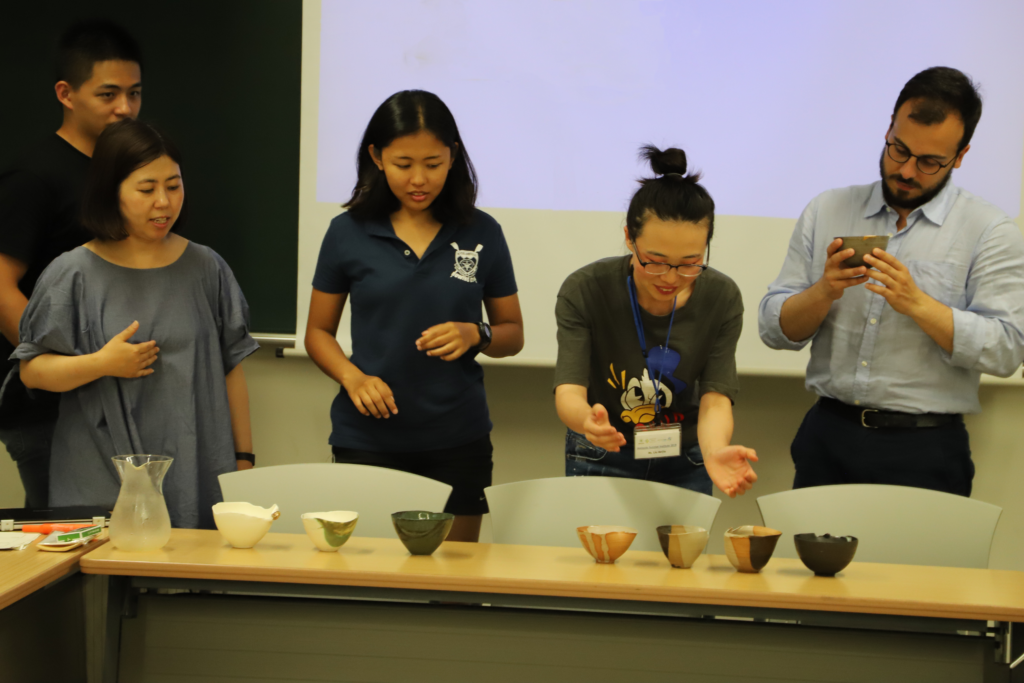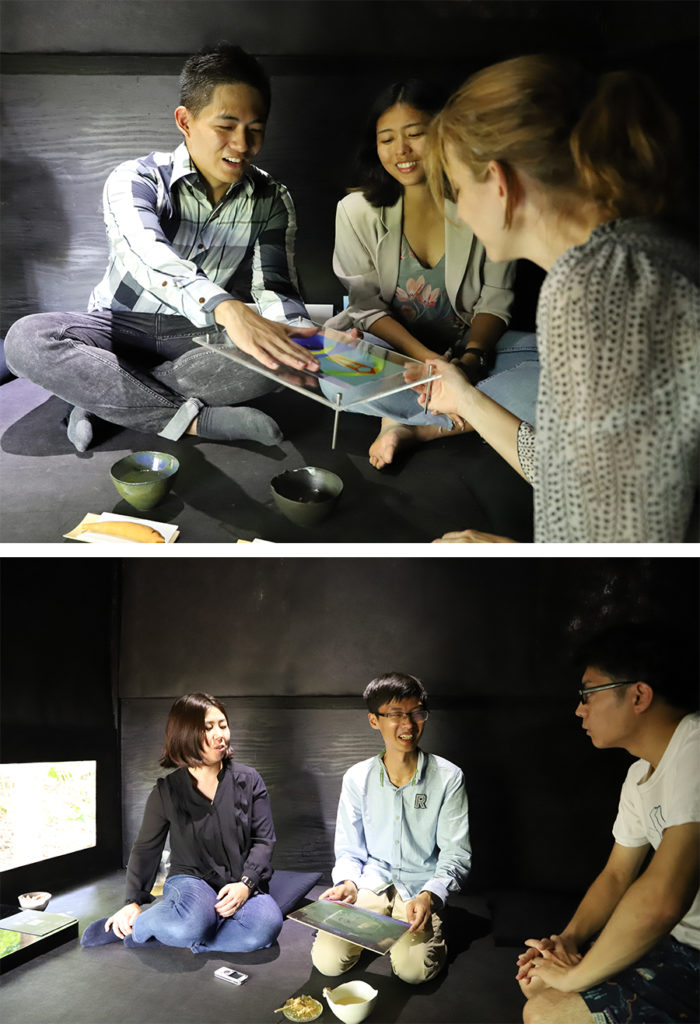HSI Report: Expressing science through tea ceremony
University News | August 10, 2018

Associate Professor Motoko Okumoto (left) chats with students about their research presentations inside of a specially built teahouse as part of the HSI “Sa-no-yu” course.
A group of international students participated in the “Sa-no-yu” Tea Ceremony for Science Communication course, a week-long program offered by the Hokkaido Summer Institute in collaboration with CoSTEP, a Hokkaido University educational organization for science and technology communication. Coming to Hokkaido University from China, Taiwan, Italy, and the Philippines, the students were able to give presentations about their research to guests in a specially built tea house located in a courtyard in Hokkaido University’s Higher Education Building.

Tea house constructed in collaboration with artist Nyubo Abe in a courtyard of the Institute for the Advancement of Higher Education.
“We created a tea room with an artist (Nyubo Abe), and I observe and research how people change their communication style inside,” said Associate Professor Motoko Okumoto, head teacher of the course and designer of the “Sa-no-yu” project. Started in Fukushima Prefecture after the March 11, 2011 earthquake and tsunami that devastated northern Japan, the project aimed to connect scientists and local residents to discuss plans for rebuilding and revitalizing the region. Okumoto explains that a tea room creates an intimate and familiar space, which allows for conversations to flow more freely than in a lecture or classroom situation. “Inside a tearoom, strangers can delve into familiar conversation immediately. It’s a comfortable space, but also an irregular one; it is a place where people can talk about concepts or ideas, rather than the ordinary.”
With this notion in mind, students in the course designed their own tea ceremony presentations from zero, starting by mapping out a storyboard to plan the flow of their presentations. They also selected which tea cups would be used, how the tea room centerpiece would be decorated, and what Japanese sweets would pair well not only with the tea, but also with the ideas they were trying to convey. Hyunjung Park, an assistant professor of art in the CoSTEP program, introduced students to the ways that Japanese food could be symbolic, and advised students on how to select snacks that would be both culturally and thematically appropriate for the tea ceremony. “As an art project, they can focus on the concepts behind their research, rather than reality,” Park said. “Science is always trying to explain, but art allows people to connect scientific issues to their feelings and daily lives.”

Students created their own centerpiece for the teahouse featuring aspects of their research (left) and selected sweets to match their research themes (right). Research themes in these lectures included 3D printing and ocean conservation, respectively.
On August 1st, students were finally able to conduct their tea ceremony and presentations in front of guests, who listened to and engaged with the students during their hour-long sessions. The inside of the tea house became quite warm throughout the afternoon, so cool tea was served. An open window in the room allowed for air to circulate, and also provided a picturesque backdrop to the student-prepared centerpiece.
Ming-Yen Hsiao, an engineering student from Taiwan, mentioned that he was excited to participate in the tea ceremony, noting “It’s different compared to other courses I took before, because students are able to work in small groups and combine their ideas with traditional Japanese culture. Italian chemistry student Lorenzo Marotti agreed, saying “This course combines communication skills and cultural insights into Japan, and as a scientist it’s very important for me to be able to deliver a message.” Pamela Renee Reyes, an undergraduate communications student from the Philippines, found the course interesting and said she would recommend it to Japanese undergraduate students who major in science. “It’s a platform for them to learn how to communicate their projects in English in a way that doesn’t come from the sciences,” she said.
The “Sa-no-yu” project has been running since 2013. The 2018 project ran from July 3rd to August 4th.
Written by Tyler Tannert


